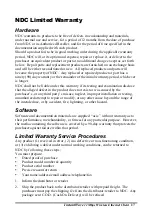
2
InstantWave
11Mbps Wireless Ethernet Client
•
Avoid placing the WEC (especially the antenna) close to metal objects (e.g.
file cabinets, metal cubicles, etc.)
•
Keep WECs as far away as possible from microwave ovens (10 meters min. is
advisable)
How to Use this Guide
The Installation Guide gives complete instructions for installation of the
InstantWave Wireless Ethernet Client (WEC).
Use the WEC COMFig tool , see page 7, to change the default WEC settings. The
WEC COMFig tool permits basic WEC offline configuration from a PC via an RS-
232 cable/COM port connection.
Terminology Used in this Guide
Domain Name
/
SSID
A “Domain” is most commonly used to refer to a group of computers whose
hostnames share a common suffix. The domain is usually defined by the network
administrator as a segment/subnet of a large network and may be made up of
overlapping wireless cells. Wireless nodes can roam freely within the same
domain without disconnecting from the network.
Regulatory Domain
InstantWave products us e the unlicensed ISM (Industrial, Scientific, Medical) band
to communicate through radio waves. Different countries offer different radio
frequencies to be used as the ISM band. There are four frequency bands defined
by IEEE 802.11: Japan (2.471GHz – 2.497 GHz), USA, Extended Japan, Canada,
and Europe (2.4 GHz – 2.4835 GHz), Spain (2.445 GHz – 2.475 GHz), and France
(2.4465 GHz – 2.4835 GHz). To use InstantWave in a country not listed above,
check with your government’s regulating body to find the correct frequency band
to use. All InstantWave products are supplied preset to the country of sale’s
frequency band.
WEP
WEP
stands for Wired Equivalent Privacy. It is an encryption scheme that
provides secure wireless data communication. WEP uses a 40-bit or 128-bit key to
encrypt data. In order to decode the data transmission, each wireless client on the
network must use identical keys.







































